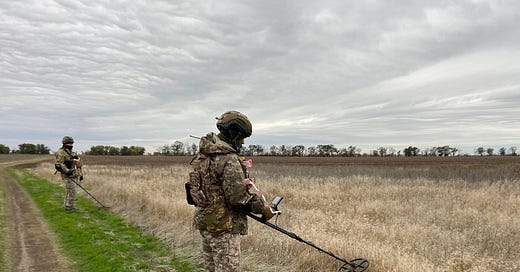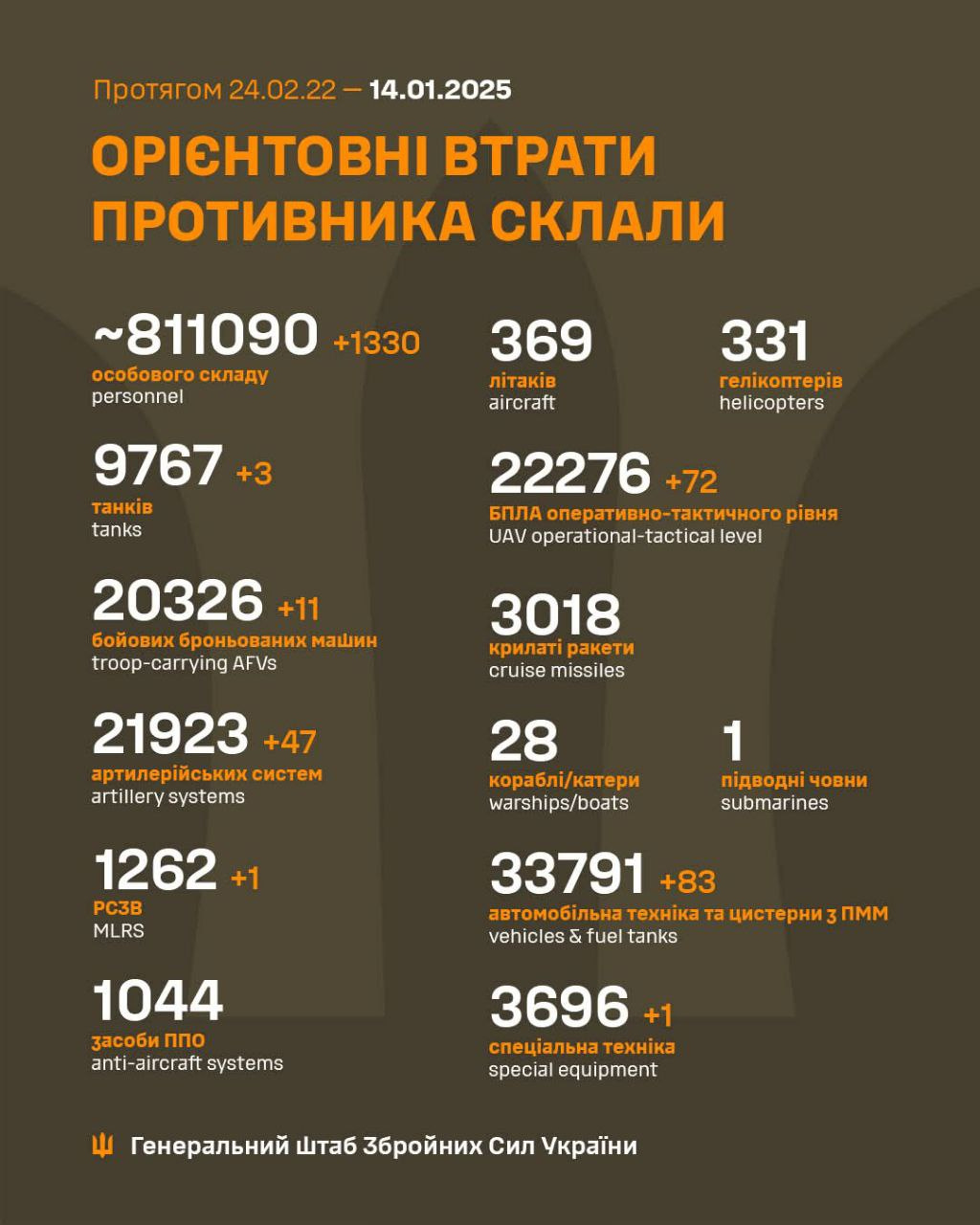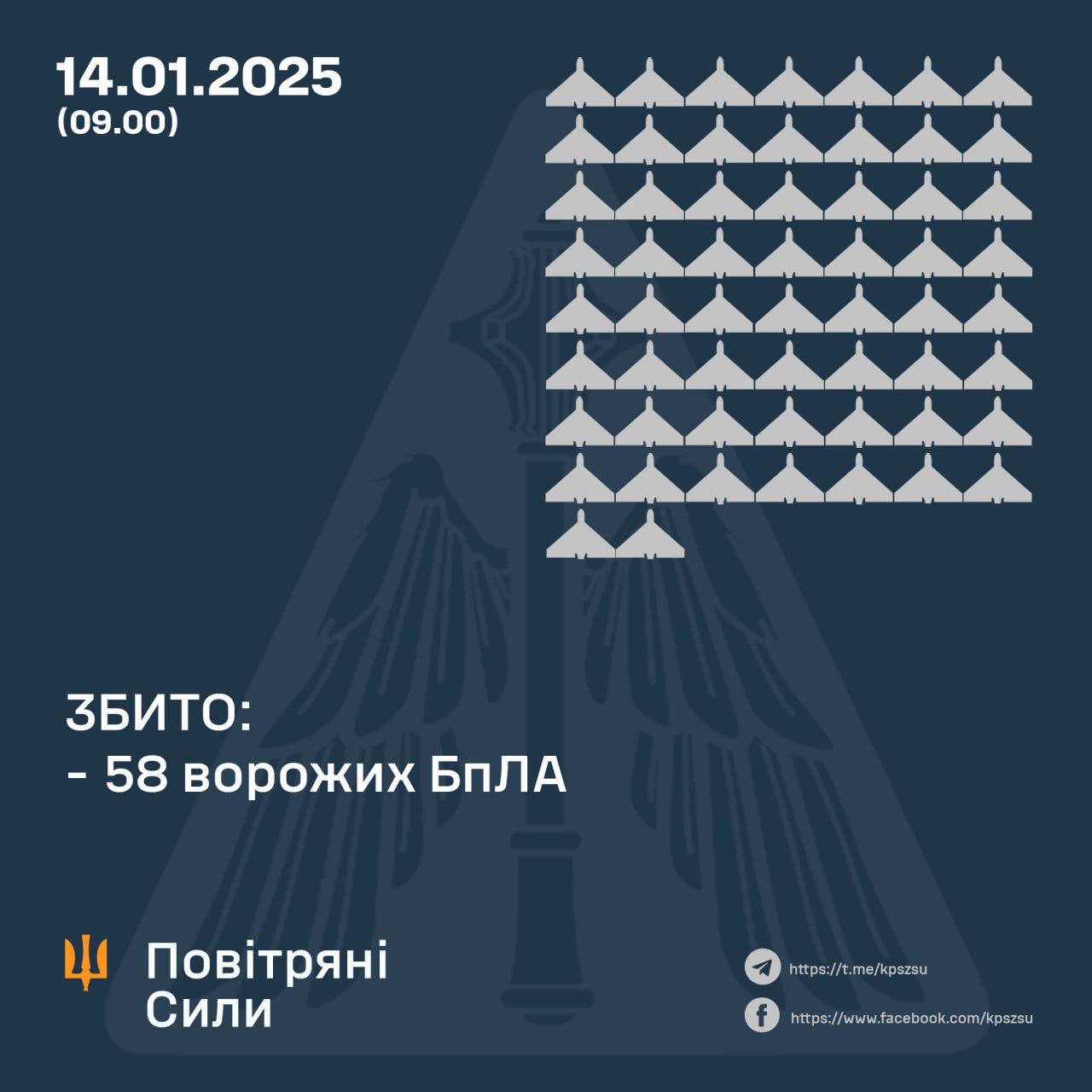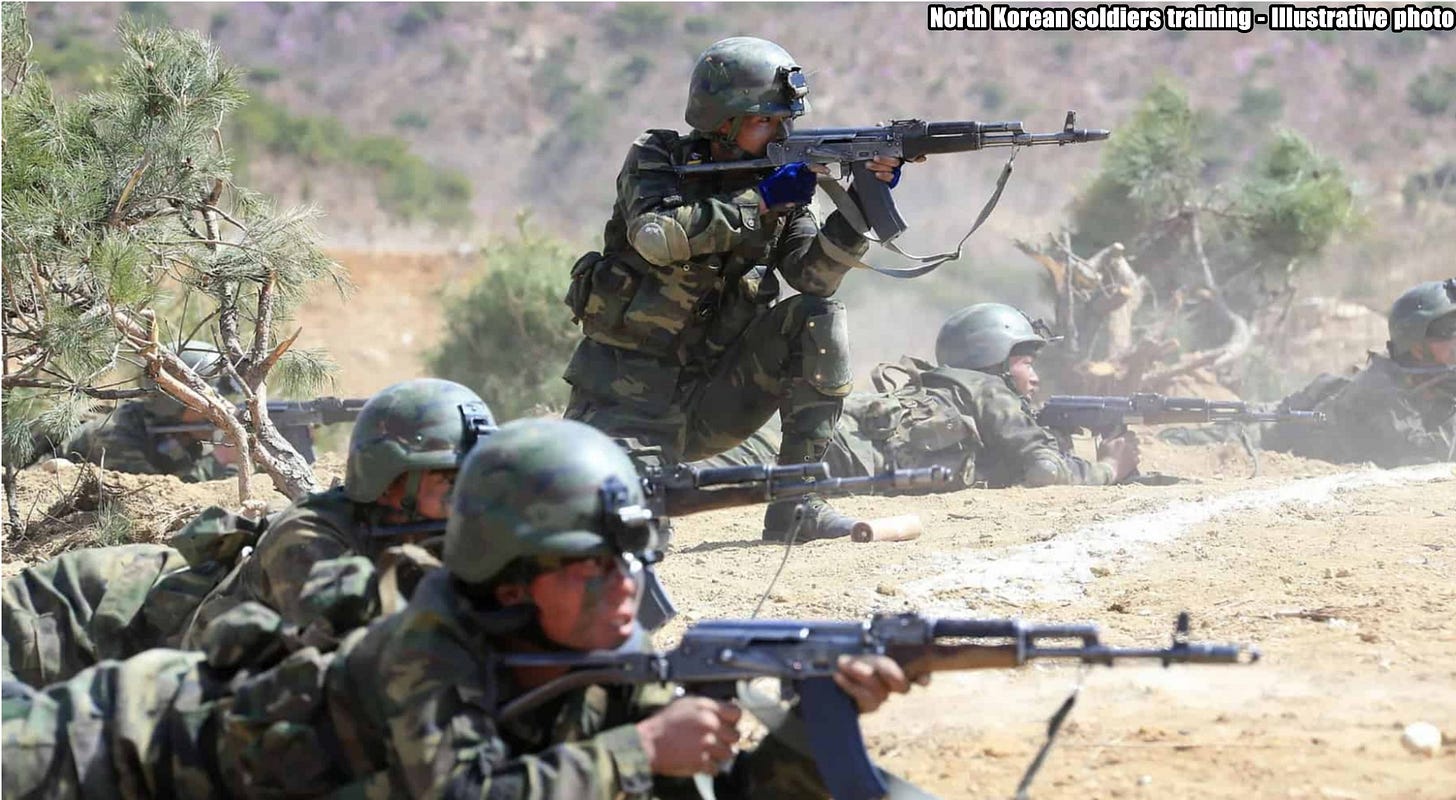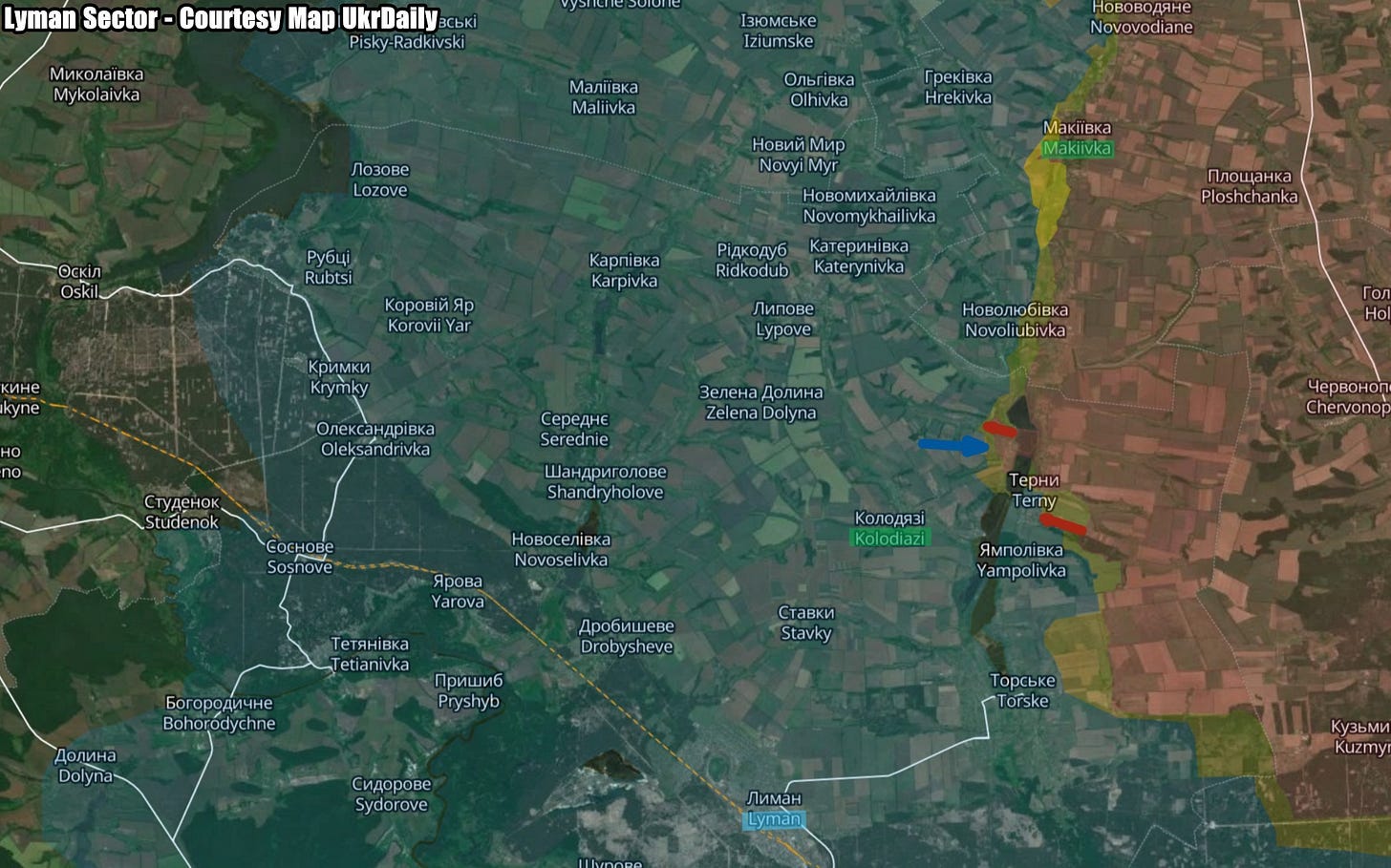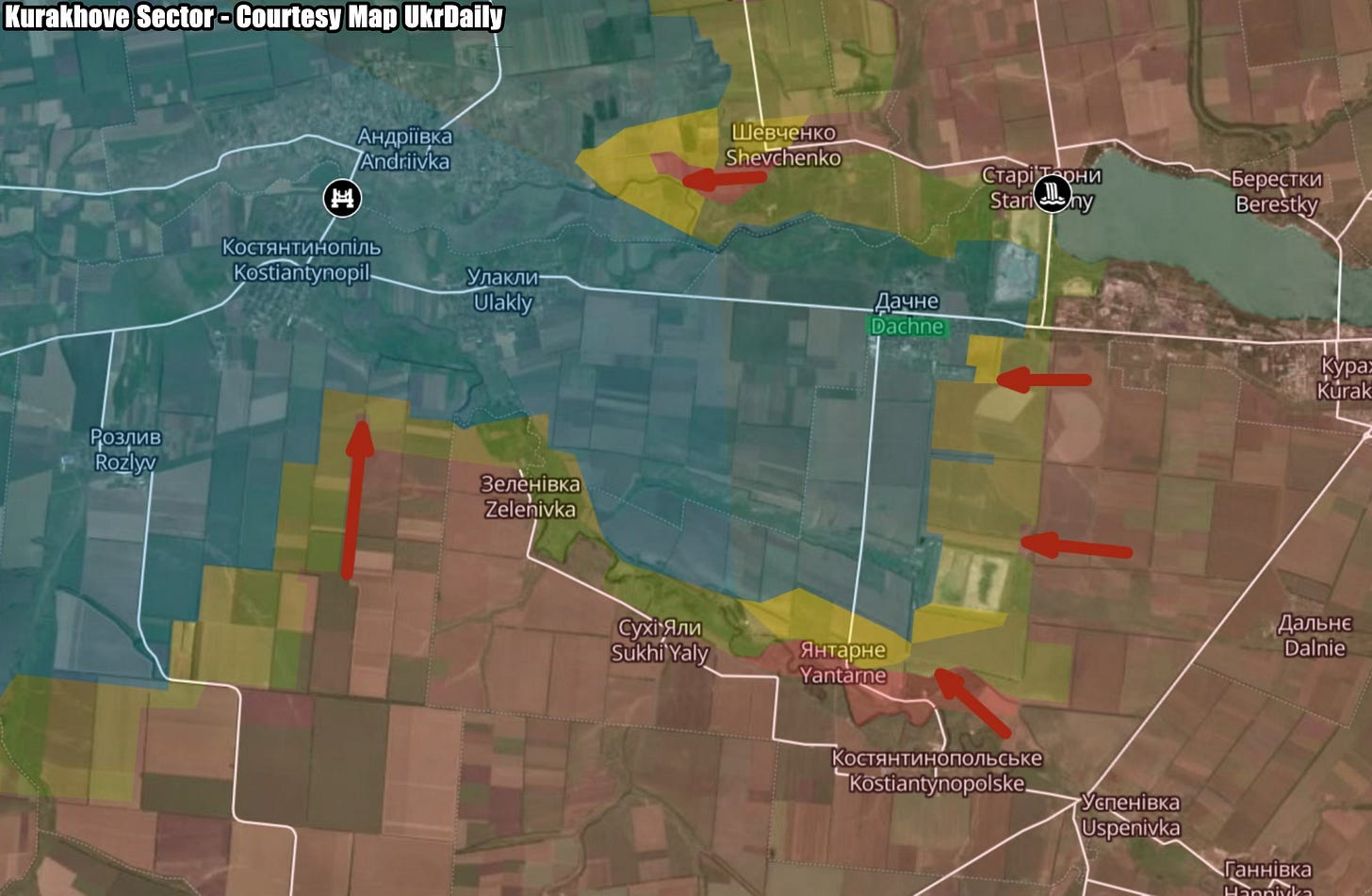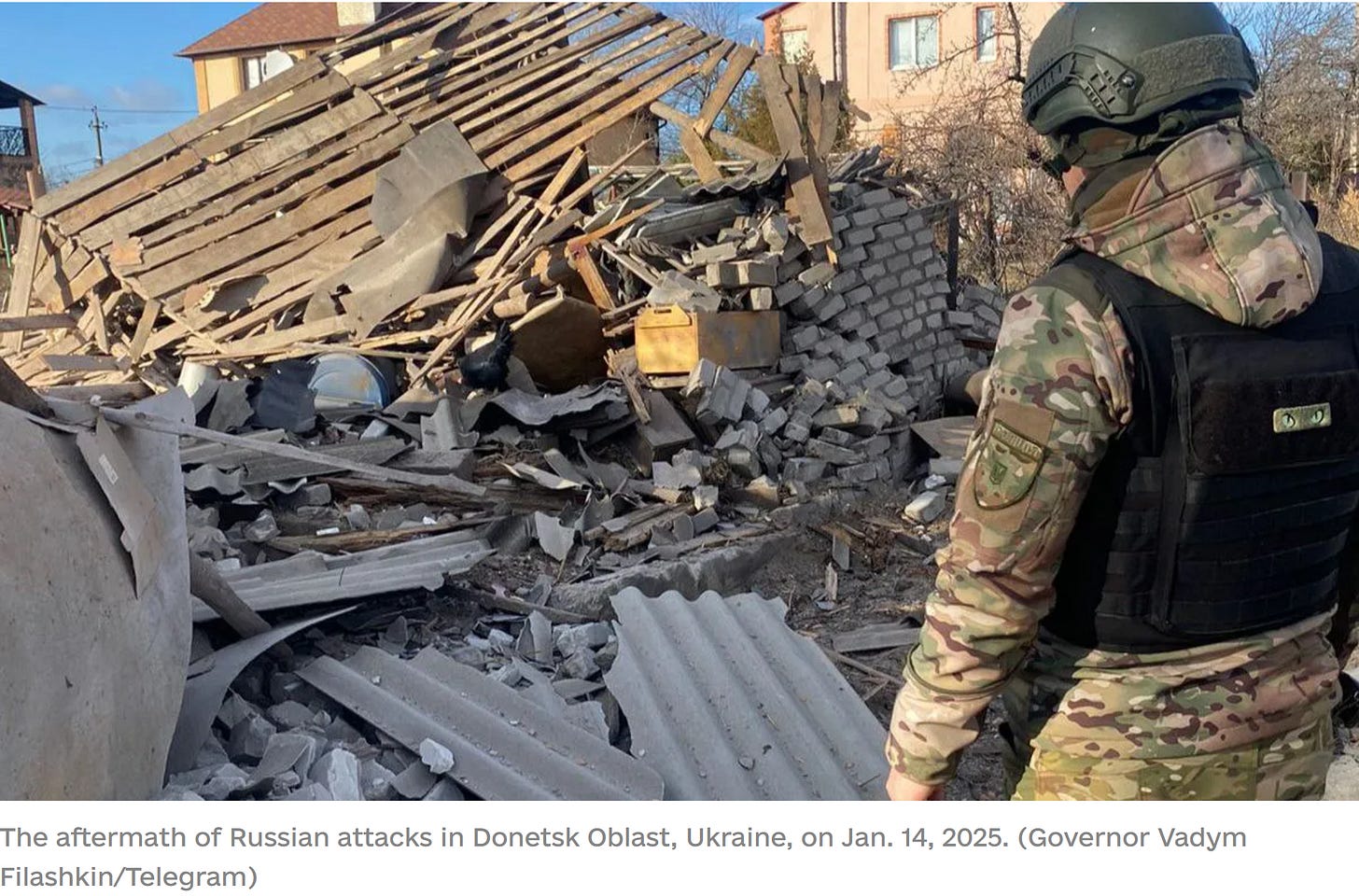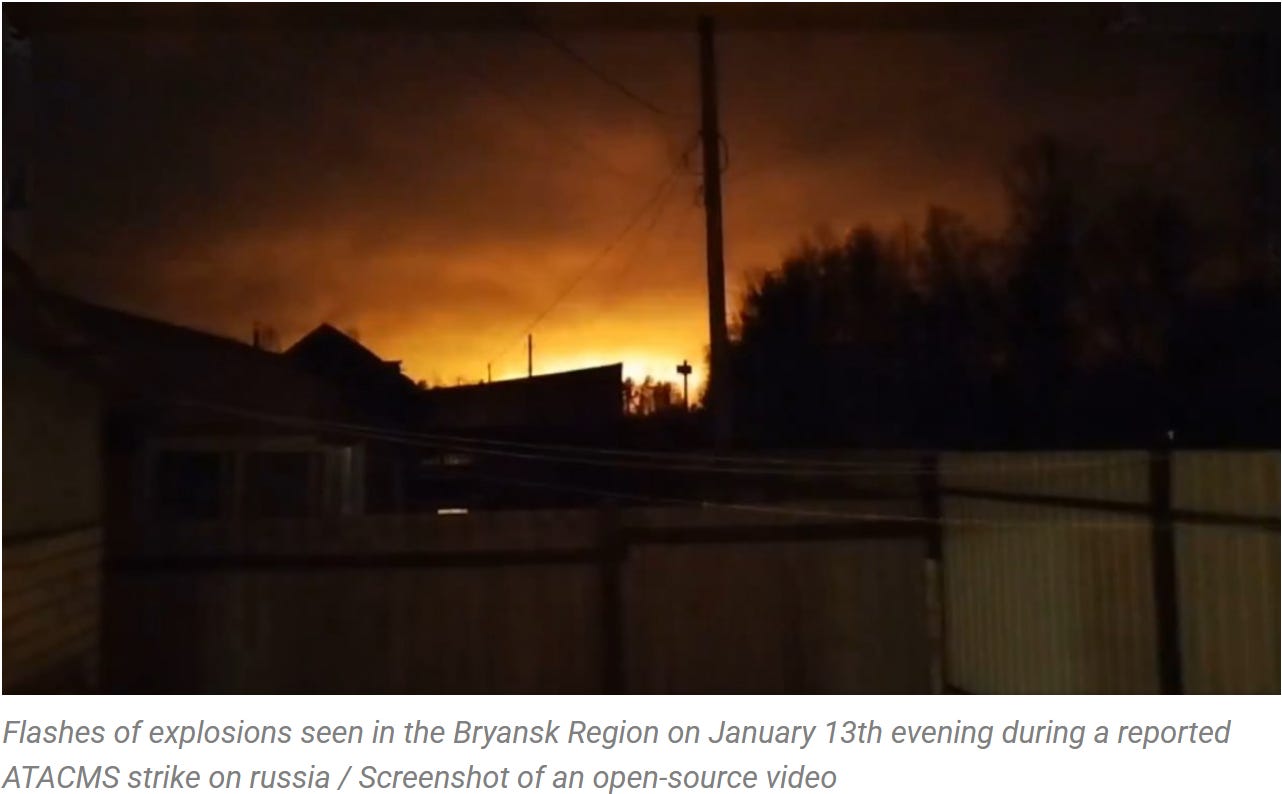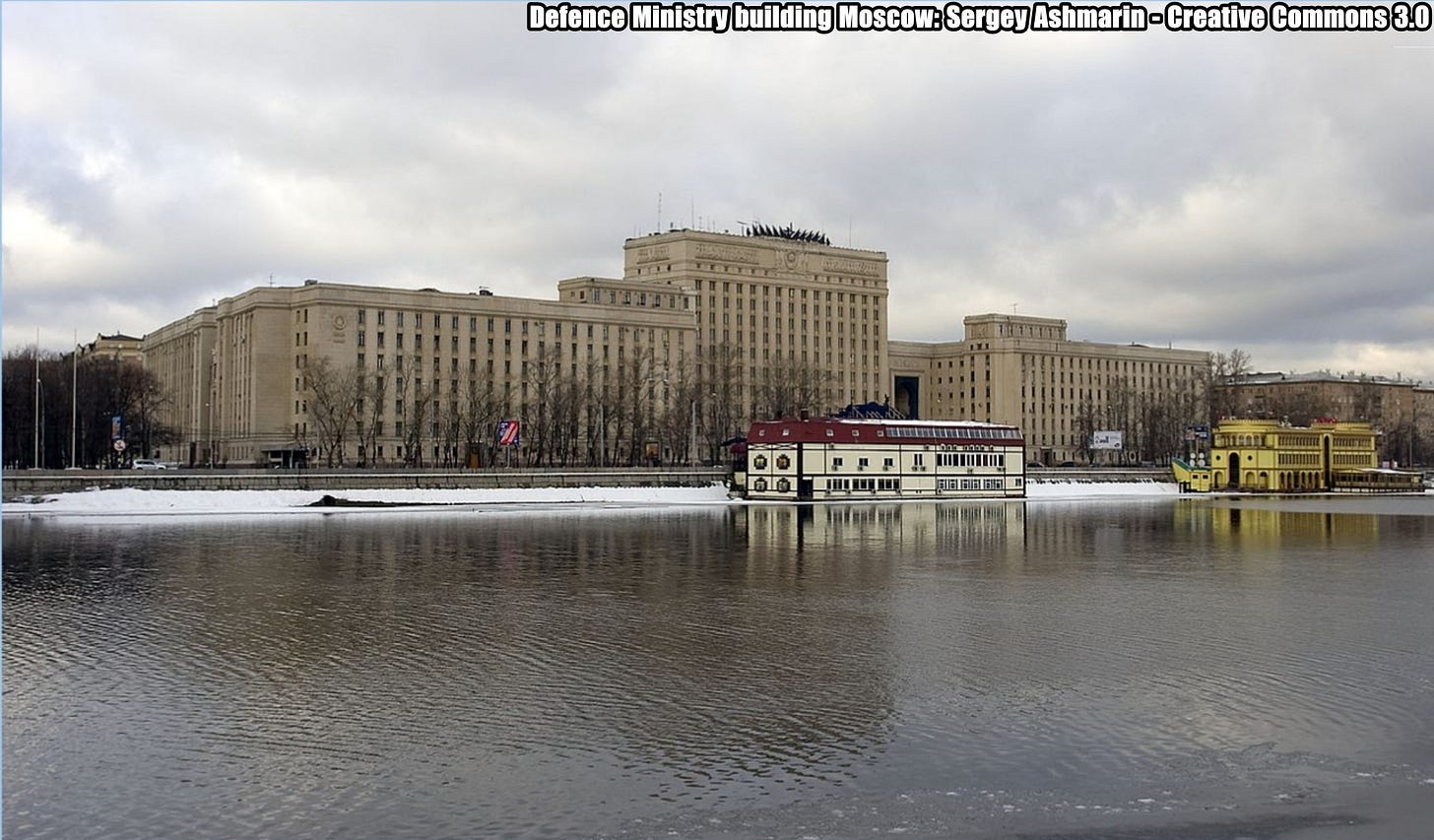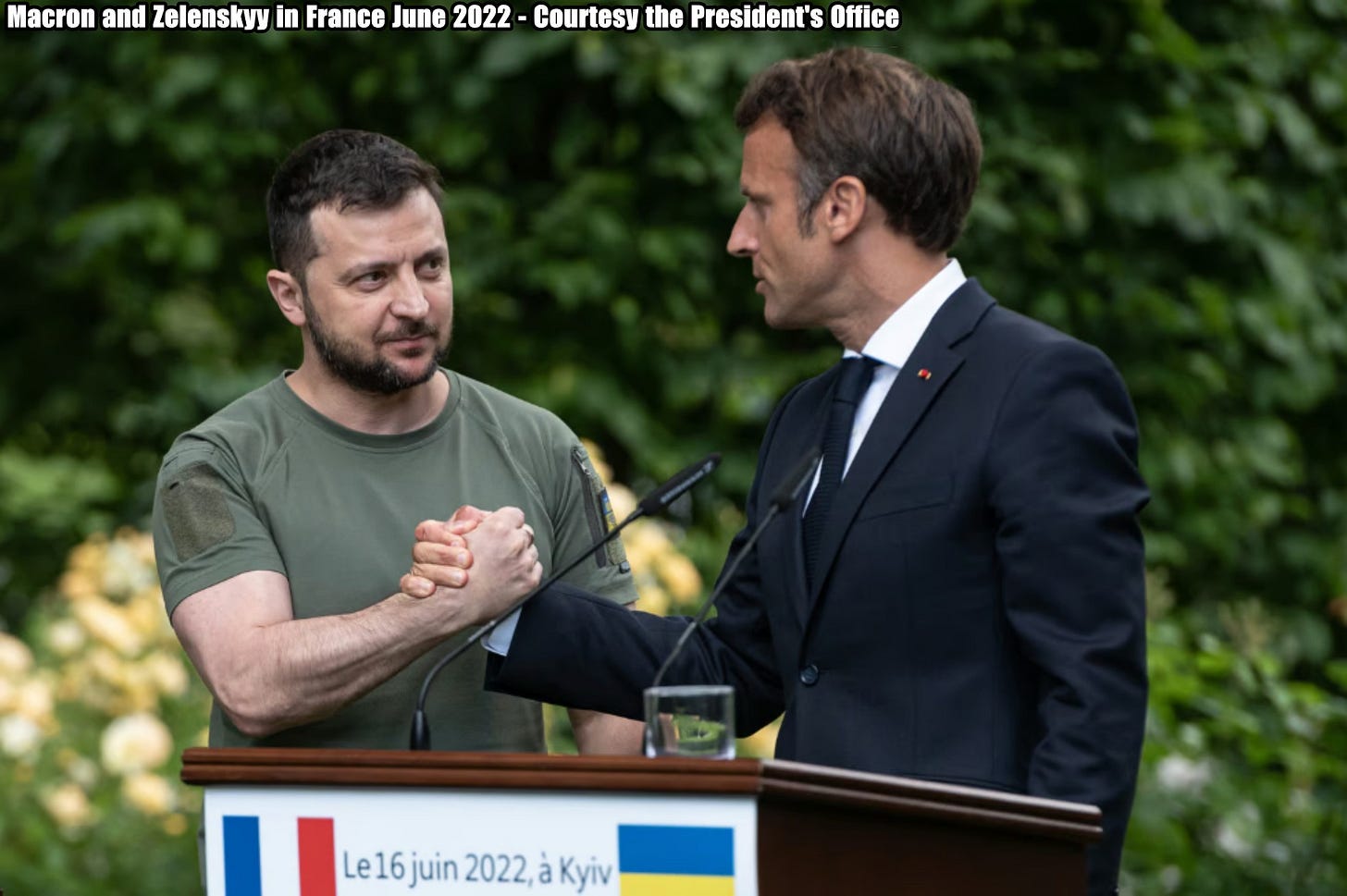Slava Ukraini! In early 2022 I began a Telegram channel aggregating news from a number of sources daily on the war in Ukraine. In June 2023 I began providing a daily draft for the Ukraine War Brief Podcast collecting news from over 70 sources daily, which formed the basis of the script. While the Podcast no longer exists I have continued to make this Brief available for my followers here on Substack for those who wish to keep up with the news from the war.
All the latest news on the Russo-Ukraine War 6 days per week
ALONG THE CONTACT LINE
GSAFU Morning Report
The General Staff of the Armed Forces of Ukraine in its Operational Information update at 08:00 on Jan 14 stated that day 1056 of the full-scale invasion of the Russian Federation against Ukraine had begun.
The situation on the line of combat remains tense in some sectors. Ukrainian defenders continue to actively counteract the Russian aggressor, causing them losses in personnel equipment and technology. Exhausting the enemy along the entire front line and continuing to disrupt the plans of Russian occupiers to advance deeper into the territory of Ukraine.
During the past day, in total 166 combat engagements took place. Over the past 24 hours, the enemy carried out 1 missile strike, 62 air strikes, used more than 684 drones and more than 3,730 artillery strikes across the positions of Ukrainian forces and civilians.
Air Force Daily Report
58 ENEMY UAVS SHOT, 21 DROPPED DID NOT REACH THEIR TARGETS (LOCATIONALLY LOST)
➖➖➖➖➖➖➖➖➖
On the night of January 14, 2025 (from 6:30 p.m. on January 13), the enemy attacked with 80 Shahed attack UAVs and simulator drones of various types from the directions of Millerovo, Orel, Kursk, Primorsko-Akhtarsk - Russia.
The air attack was repelled by aviation, anti-aircraft missile troops, electronic warfare units, and mobile fire groups of the Air Force and Defense Forces of Ukraine.
As of 09:00, it was confirmed that 58 Shahed attack UAVs and drones of other types were shot down in Poltava, Sumy, Kharkiv, Cherkasy, Kyiv, Zhytomyr, Kirovohrad, Dnipropetrovsk, Mykolaiv, Odessa and Kherson regions.
Downed enemy drones caused damage in Sumy, Kyiv, Zhytomyr, Kharkiv and Cherkasy regions. Private and apartment buildings, cars, and property of citizens were damaged. No casualties have been reported so far, and assistance is being provided to the victims.
21 enemy drone simulators — lost in location (without negative consequences).
Combat Operations in the Russian Federation
The Institute for the Study of War (ISW), a US based think tank, in its Jan 13 Russian Offensive Campaign Assessment reported that Russian forces continued offensive operations within the Ukrainian salient in Kursk Oblast on Jan 13 but did not make any confirmed advances. Russian milbloggers claimed that fighting continued northwest of Sudzha near Pogrebki and Kruglenkoye; northeast of Sudzha near Russkoye Porechnoye; and southeast of Sudzha near Makhnovka.
Ukrainian Special Operations Forces (SSO) reported on Jan 13 that they recently repelled a North Korean infantry assault in Kursk Oblast that lasted from morning until night.
North Korea's suicide soldiers pose new challenge for Ukraine in war with Russia
After a battle in Russia's snowy western region of Kursk this week, Ukrainian special forces scoured the bodies of more than a dozen slain North Korean enemy soldiers. Reuters reports.
Among them, they found one still alive. But as they approached, he detonated a grenade, blowing himself up, according to a description of the fighting posted on social media by Ukraine's Special Operations Forces on Monday.
The forces said their soldiers escaped the blast uninjured. It is among mounting evidence from the battlefield, intelligence reports and testimonies of defectors that some North Korean soldiers are resorting to extreme measures as they support Russia's three-year war with Ukraine.
"Self-detonation and suicides: that's the reality about North Korea," said Kim, a 32-year-old former North Korean soldier who defected to the South in 2022, requesting he only be identified by his surname due to fears of reprisals against his family left in the North.
"These soldiers who left home for a fight there have been brainwashed and are truly ready to sacrifice themselves for Kim Jong Un," he added, referring to the reclusive North Korean leader.
Kim, introduced to Reuters by Seoul-based human rights group NK Imprisonment Victims' Family Association, said he had worked for North Korea's military in Russia for about seven years up until 2021 on construction projects to earn foreign currency for the regime.
Ukrainian and Western assessments say Pyongyang has deployed some 11,000 soldiers to support Moscow's forces in Russia's western Kursk region, which Ukraine seized in a surprise incursion last year. More than 3,000 have been killed or injured, according to Kyiv.
North Korea's mission to the United Nations in Geneva did not immediately respond to a request for comment.
Moscow and Pyongyang initially dismissed reports about the North's troop deployment as "fake news". But Russian president Vladimir Putin in October did not deny that North Korean soldiers were currently in Russia and a North Korean official said any such deployment would be lawful.
Ukraine this week released videos of what it said were two captured North Korean soldiers. One of the soldiers expressed a desire to stay in Ukraine, and the other to return to North Korea, Ukrainian President Volodymyr Zelenskiy said.
North Korea's deployment to Russia is its first major involvement in a war since the 1950-53 Korean War. North Korea reportedly sent a much smaller contingent to the Vietnam War and to the civil conflict in Syria.
The United States has warned the experience in Russia will make North Korea "more capable of waging war against its neighbours".
North Korea's leader Kim has previously hailed his army as "the strongest in the world", according to state media. Propaganda videos released by the regime in 2023 showed bare-chested soldiers running across snowy fields, jumping into frozen lakes and punching blocks of ice for winter training.
But a South Korean lawmaker briefed by the country's spy agency on Monday said that the numbers of North Korean soldiers wounded and killed on the battlefield suggests they are unprepared for modern warfare, such as drone attacks, and may be being used as "cannon fodder" by Russia.
More worryingly there are signs these troops have been instructed to commit suicide, he said.
"Recently, it has been confirmed that a North Korean soldier was in danger of being captured by the Ukrainian military, so he shouted for General Kim Jong Un and pulled out a grenade to try to blow himself up, but was killed," Lee Seong-kweun, who sits on the South Korean parliament's intelligence committee, said.
Memos carried by slain North Korean soldiers also show that North Korean authorities emphasized self-destruction and suicide before capture, he added.
When asked about further details of the cases he referred to, he declined to elaborate saying it was information from Ukraine shared with South Korea's National Intelligence Service (NIS). NIS did not answer calls seeking comment on Tuesday.
Suicides by soldiers or spies not only show loyalty to the Kim Jong Un regime but are also a way to protect their families left at home, Yang Uk, a defence analyst at the Asan Institute of Policy Studies said.
Ukraine's President Zelenskyy said on Sunday Kyiv is ready to hand over captured North Korean soldiers to their leader Kim Jong Un if he can facilitate their exchange for Ukrainians held captive in Russia.
For some North Korean soldiers, however, being captured and sent back to Pyongyang would be seen as a fate worse than death, said Kim, the North Korean defector and former soldier.
"Becoming a prisoner of war means treason. Being captured means you are a traitor. Leave one last bullet, that's what we are talking about in the military," he said.
The Khortytsia operational-strategic group
(Responsible for the northeastern part of Ukraine. )
Lyman Sector: Russian forces advance marginally on Jan 13 in the vicinity of Makiivka and Kolodiazi.
The Tavria operational-strategic group
(Responsible for the central-eastern and southeastern part of Ukraine.)
Pokrovsk Sector : The Institute for the Study of War (ISW), a US based think tank, in its Jan 13 Russian Offensive Campaign Assessment reported that Russian forces recently cut the T-0405 Pokrovsk-Kostyantynivka highway east of Pokrovsk and the T-0406 Pokrovsk-Mezhova highway southwest of Pokrovsk as part of their efforts to envelop Pokrovsk and Myrnohrad. Geolocated footage published on Jan 12 indicates that Russian forces recently advanced east of Myrne (east of Pokrovsk) and seized positions along the T-0504 highway.
Ukrainian military observer Kostyantyn Mashovets stated on Jan 13 that elements of the Russian 55th and 74th motorized rifle brigades (41st Combined Arms Army [CAA], Central Military District [CMD]) recently advanced to and cut the T-0406 highway between Kotlyne and Udachne (both southwest of Pokrovsk), and Russian milbloggers claimed that Russian forces seized a section of both highways. ISW assesses that Russian forces likely seized the remainder of Solone (southwest of Pokrovsk) as part of this advance.
ISW previously noted that Russian forces could also leverage advances east of Pokrovsk near Vozdvyzhenka and Myrne to eliminate the Ukrainian salient southwest of Toretsk along the H-20 Donetsk City-Kostyantynivka highway.
Russian forces also advanced in other areas southwest of Pokrovsk amid ongoing efforts to envelop the town on Jan 12. Geolocated footage published on Jan 13 indicates that Russian forces seized Pishchane (southwest of Pokrovsk).Russian forces continued attacking near Pokrovsk itself; northeast of Pokrovsk near Baranivka, Zelene Pole, Nova Poltavka, and Tarasivka; east of Pokrovsk near Novotoretske, Novooleksandrivka, Myrolyubivka, Yelyzavetivka, Promin, and Myrnohrad; southeast of Pokrovsk near Lysivka; south of Pokrovsk near Novyi Trud, Zelene, and Shevchenko; southwest of Pokrovsk near Udachne, Uspenivka, Novovasylivka, Novoandriivka, Sribne, and Yasenove; and west of Pokrovsk near Kotlyne on Jan 12 and 13.
Kurakhove Sector: Russian forces advanced marginally west from Kurakhove towards Dachne on Jan 12.
Vremivka Sector: Russian forces recently advanced in the Velyka Novosilka direction amid continued offensive operations in the area on Jan 13. Geolocated footage published on Jan 12 and 13 indicates that Russian forces operating north of Velyka Novosilka advanced to the east (left) bank of the Mokri Yaly River southwest of Novyi Komar and that Russian forces likely seized Neskuchne (southwest of Velyka Novosilka).
The Odesa operational-strategic group
(Responsible for Kherson, Qırım, (also known as Crimea) and the Black Sea.)
There have been no major changes to the combat environment since our last report.
TEMPORARILY OCCUPIED TERRITORIES
Nothing major to report.
THE HOME FRONT
Russian attacks against Ukraine kill 2, injure 19 over past day.
Russian attacks against Ukraine killed at least two people and injured 19, including children, over the past day, regional authorities reported on Jan. 14.
Russia attacked Ukraine with 80 Shahed-type drones and various other unmanned aerial vehicles (UAV) overnight, Ukraine’s Air Forces reported on their Telegram channel. Air defenses shot down 58 drones over 11 oblasts, while 21 dummy drones were lost in the airspace, the Air Force said.
Two people were killed and two others injured in Donetsk Oblast as a result of Russia’s attacks, Governor Vadym Filashkin reported on his Telegram channel.
Nine people were injured as a result of the Russian military’s attacks on the city of Kherson and 33 other regional settlements, Kherson Oblast Governor Oleksandr Prokudin reported.
Three people were injured, including a 14-year-old girl, in a Russian attack in Dnipropetrovsk Oblast, Governor Serhii Lysak reported. The two adult victims were hospitalized with moderate injuries.
In Kharkiv Oblast, five people were injured in Russian attacks, including two infants, according to Governor Oleh Syniehubov.
RUSSIAN WORLD
Ukraine targets Russia's industrial plants, ammunition depots in 'massive' strike.
Ukraine launched its "most massive" attack against Russian military and industrial facilities in a range of up to 1,100 kilometers (620 miles) overnight on Jan. 14, The Kyiv Independent reports citing the General Staff of Ukraine’s Armed Forces.
Chemical plants, refineries, and the Engels airbase's ammunition depots were successfully targeted, a source in the Security Service of Ukraine (SBU) told the Kyiv Independent.
"The SBU, together with the Defense Forces, continues to strike enemy military facilities and enterprises supporting Russia’s military-industrial complex. Each hit — whether on ammunition depots, refineries, oil depots, or chemical plants — weakens Russia’s capacity to wage war in Ukraine," an SBU source told the Kyiv Independent.
Ukrainian drones reportedly targeted multiple regions, including Saratov, Voronezh, and Orel oblasts, as well as Tatarstan. The Russian Defense Ministry did not specify the number of drones involved.
Dmitry Milyaev, the governor of Russia's Tula region, described a "massive drone attack" in a Telegram post, claiming at least 17 drones were launched. In Aleksin, debris from a downed drone reportedly damaged vehicles and outbuildings, with no casualties reported.
The SBU source indicated the Aleksino chemical plant — producing gunpowder and ammunition for the Russian military — was successfully hit, igniting a large fire.
In Saratov and Engels, Governor Roman Busargin confirmed damage at two industrial facilities following drone strikes.
The General Staff said that the Kristal oil facility in Engels, which burned for five days after an earlier strike on Jan. 8, was again successfully targeted.
The Engels airfield, located in Saratov Oblast over 750 kilometers (460 miles) from Ukraine's nearest controlled territory, allegedly sustained hits to ammunition depots containing FAB glide bombs, KAB bombs, and cruise missiles. The Saratov oil refinery was also reportedly engulfed in a fire.
Engels hosts three types of Russian strategic bombers — the Tupolev Tu-95, Tu-22, and Tu-160 — all frequently used to launch missile strikes on Ukrainian cities.
Mikhail Isayev, the acting head of the Engels district, announced that schools in the city would transition to remote learning due to the continued threat of drone strikes.
Explosions were reported in the town of Seltso near Bryansk, where the chemical plant reportedly was hit, according to the Russian opposition Telegram channel Astra.
Ukraine’s Unmanned Systems Forces confirmed the strike, saying that the plant produces gunpowder, explosives, and missile fuel components, including ammunition for barrel artillery, multiple launch rocket systems (MLRS), aircraft, and Kh-59 cruise missiles. It also carries out overhauls of Grad, Uragan, and Tornado-G MLRS.
The unit reported that the drones distracted Russian air defense, paving the way for missiles to hit the main targets. Following the missile strike, long-range drones allegedly destroyed substations and other critical infrastructure.
In Tatarstan’s capital, Kazan, a fuel facility was struck in the early hours of Jan. 14, igniting a gas tank. The fire occurred about 1,000 kilometers (621 miles) from the Ukrainian border. Tatarstan Republic head Rustam Minnikhanov confirmed that a fire broke out in the city as a result of the drone strike but claimed that it resulted in no significant damage.
FSB officer suspected murder in Moscow Defence Ministry Building.
Russian Federal Security Service (FSB) counterintelligence officer Vladimir Feshchenko was found dead in a Russian Defense Ministry building in Moscow, the Kyiv Independent reported citing Russian propaganda outlet RIA Novosti on Jan. 14.
Preliminary information suggests he was murdered, an undisclosed source told the news agency. The pro-Kremlin Telegram channel Baza also described the death as violent, citing a deep wound in Feshchenko’s forehead.
The body was discovered in a building on Olkhovskaya Street, which houses the Russian Defense Ministry and the FSB Office for the Moscow Military District.
While Baza identified Feshchenko as a Russian weightlifting champion and international master of sports, his status as an FSB officer was not indicated.
The Vchk-Ogpu Telegram channel, known for connections to Russian security forces, confirmed his affiliation with the FSB.
According to Vchk-Ogpu, Feshchenko was allegedly killed during a conflict with a friend with whom he had previously served in the Far East. The suspect, reportedly detained, has pleaded guilty to the murder.
The Russian Justice Ministry has designated Vchk-Ogpu as a "foreign agent," accusing the Telegram channel of spreading allegedly false information about government decisions and creating a negative image of the Russian military.
The FSB has gained notoriety for suppressing dissent, targeting activists, independent journalists, and pro-democracy movements. President Vladimir Putin has also tasked the agency with locating Russian nationals fighting for Ukraine’s military or pro-Kyiv militias.
Feshchenko’s death highlights mounting internal tensions within Russia’s security and military institutions amid the ongoing war in Ukraine.
INTERNATIONAL NEWS
Macron, Zelenskyy discuss 'practical steps' for deploying peacekeeping troops in Ukraine.
President Volodymyr Zelenskyy and French President Emmanuel Macron discussed the situation on the front line and the possibility of sending peacekeeping troops to Ukraine in a phone call on Jan. 13. The Kyiv Independent reported,
The idea of deploying a peacekeeping force on the ground in Ukraine has gained traction in recent months as European nations prepare to play a greater role in Kyiv's defense once U.S. President-elect Donald Trump takes office on Jan. 20.
"(W)e discussed the French initiative to deploy military contingents in Ukraine," Zelenskyy said following the call.
"We considered practical steps for its implementation, possible expansion, and involvement of other countries in this process."
Macron has put forth the idea of sending troops to Ukraine in some capacity since February 2024. With Zelenskyy and Macron previously discussed the possibility of a peacekeeping force in a meeting on Dec. 18. In their trilateral meeting with Trump in Paris on Dec. 7, Trump reportedly said he wants European troops to monitor a potential ceasefire in Ukraine.
U.K. Prime Minister Keir Starmer also plans to visit Ukraine in the coming weeks to discuss the potential deployment of an international peacekeeping force, Bloomberg reported on Jan. 10.
Zelenskyy and Macron agreed to meet in the near future to further discuss plans to achieve security guarantees, including the possible deployment of peacekeepers.
The two leaders also discussed the situation in Kursk Oblast, amid a renewed offensive by Ukrainian forces in the region. Zelenskyy highlighted Ukraine's current air defense priorities and ongoing need for high-precision long-range weapons.
65 oil tankers drop anchor after latest US sanctions against Russia.
Sixty-five oil tankers paused operations in various places around the world following the recent U.S.-U.K. sanctions against Russia’s oil industry and shadow fleet, the Kyiv Independent reported citing Reuters Jan. 13, examination of maritime tracking data.
According to the news agency, five of those tankers were anchoring off China and Singapore, while others were idling in the Baltic Sea and near Russia's Far East.
The latest sanctions targeted more than 180 oil-carrying vessels of Russia's so-called shadow fleet, a group of aging tankers routinely used for sanction evasion. Several of these vessels are also reportedly involved in transporting sanctioned Iranian oil.
Experts cited by Reuters said the latest measures drove up prices of tankers as demand for non-sanctioned vessels grew.
The recent sanctions also targeted two of Russia's major oil producers, Gazprom Neft and Surgutneftegaz, along with dozens of their subsidiaries.
Combined, these companies reportedly produce over 1 million barrels of oil daily, generating an estimated $23 billion of revenue annually, according to the U.S. Treasury Department.
The sanctions also extend to dozens of Russian energy officials and corporate executives, further tightening restrictions on Moscow's oil industry.
Australia making 'urgent inquiries' after reports of volunteer fighter's execution in Russian captivity.
Canberra is making "urgent inquiries" about the status of Australian citizen Oscar Jenkins, a volunteer soldier captured by Russia while fighting for Ukraine, after reports of his death, the 7News outlet wrote on Jan. 14
Undisclosed sources in Ukraine told 7News that the body of Jenkins, a 32-year-old teacher from Melbourne whose capture was reported in December, has been found. He is believed to have been executed by his Russian captors.
Australian officials are yet to confirm Jenkins' death, while Australia's Foreign Ministry has summoned the Russian ambassador to "seek information" and urge Moscow to comply with international law.
7News reported "speculations" that Jenkins' body has been found but is yet to be officially identified, without providing details on the circumstances of the body's discovery. Ukrainian authorities are said to be working to verify the reports..
The Geneva Conventions mandate all warring parties to treat prisoners of war (POW) with respect and dignity, while executing POWs is considered a gross violation of international law and a war crime. Russia has been repeatedly accused of summarily executing Ukrainian POWs throughout the war.
Moscow calls foreign volunteers "mercenaries" and claims they are not entitled to protection under the Geneva Conventions.
A spokesperson of the Australian Foreign Ministry told the local media that the government has "grave concerns for Mr Jenkins's welfare."
If confirmed, this would be the first Australian volunteer fighter captured and executed by Russia during the full-scale war. At least six other Australians are believed to have been killed while fighting on Ukraine's side.
In a video that emerged on Russian Telegram channels in late December, Jenkins is seen in military fatigues, interrogated by Russian captors. The man behind the camera asks the captive about his name and background and whether he wants to live while beating him over the head.
Jenkins, who reportedly served in Ukraine's International Legion, introduces himself in the video as a biology teacher who wanted to help Ukraine and is now based near Kramatorsk, a Ukrainian city in Donetsk Oblast, around 700 kilometers (430 miles) east of Kyiv and 20 kilometers (12 miles) west of the front line.
Unlike most other foreigners volunteering to join Ukraine's resistance against Russia, Jenkins has had no military experience. The Australian media described the man as "much loved" by his community in Australia, a talented cricket and football player who studied biomedical sciences before working as a lecturer in China. He is believed to have traveled to Ukraine in 2024.
MILITARY & TECH
Thousands of Lithuanian drones for Ukraine stuck in warehouses.
Thousands of drones manufactured in Lithuania and intended for delivery to Ukraine remain in storage, with delays attributed to bureaucratic hurdles. Defence Blog reports.
The drones, procured to support Ukraine’s military efforts, were initially expected to reach their destination by the end of 2024. Manufacturers warn that the delays are impacting Ukraine’s ability to defend itself effectively.
One such company, RSI Europe, which supplied the drones, expressed frustration over the situation. “We delivered part of the drones in October and the rest in November, but we have no confirmation that the drones have been transported to Ukraine,” said RSI Europe CEO Tomas Milašauskas.
The company has also not been invited to train Ukrainian personnel on the drones’ operation, further complicating the situation. Other Lithuanian manufacturers confirmed similar issues, stating they have no updates on whether the drones have left Lithuania.
Former Lithuanian Defense Minister Laurynas Kasčiūnas blamed bureaucratic inefficiencies for the delays. According to Kasčiūnas, there are six steps required for transferring military equipment to Ukraine, including formal approvals and logistical arrangements.
“The process involves warehouses, the Defense Resources Agency formally transferring the equipment to the military, a government decision to approve the transfer, and then physically transporting the items to Ukraine. Each step must be expedited,” Kasčiūnas explained.
Drone manufacturers emphasized the urgency of getting the equipment to Ukrainian forces. “If the drones are not in soldiers’ hands, Ukraine suffers greater losses than necessary,” Milašauskas warned.
The Chairman of Lithuania’s Parliamentary Committee on National Security and Defense, Gedrimas Eglinskas, highlighted the importance of delivering modern technology promptly. “Drones manufactured to the latest standards must reach Ukrainian soldiers as quickly as possible,” Eglinskas stated, urging for a systemic overhaul to prevent future delays.
Lithuania’s Ministry of Defense assured that the delivery process is being expedited. Recent government decisions have streamlined procedures, eliminating the need for additional approvals for state-purchased equipment meant for other countries.
“Going forward, we will begin transferring property to Ukraine under these revised procedures,” the ministry announced in a statement.
Earlier this year, five Lithuanian drone manufacturers successfully tested their products in Ukraine, and nearly 5,000 drones worth €5 million were purchased for Ukraine’s armed forces. Additionally, 2,300 combat drones valued at €3 million were procured for Lithuania’s own military.
While the Ministry of Defense originally promised all drones would be delivered by the end of 2024, the delays have raised questions about whether such timelines are achievable. Experts hope the streamlined procedures will prevent similar issues in the future.
As the drones remain in warehouses, both Ukrainian forces and Lithuanian manufacturers await concrete progress in their deployment.
That’s it for today’s Brief folks if you would like to keep up with events in Ukraine daily please consider subscribing, it’s free!


